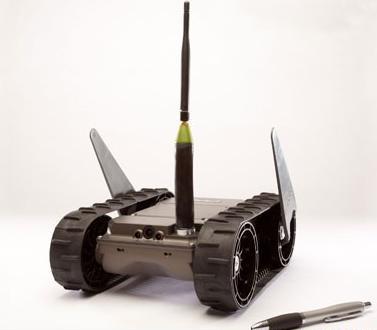With tongue firmly placed in cheek, Military’s & Aerospace Electronics Report’s John Keller expresses his concern about the latest social ill. After viewing the numerous displays of rugged, ”throwable” robots at the recent AUVSI gathering, he worries about Unmanned Vehicle Abuse. Video below.
Posts
 In the early days of the Afghanistan and Iraqi wars, US forces had no effective countermeasures against Improvised Explosive Devices (IEDs), the single biggest cause of combat deaths. To fight the IED threat, our armed forces turned to Unmanned Ground Vehicles (UGV).
In the early days of the Afghanistan and Iraqi wars, US forces had no effective countermeasures against Improvised Explosive Devices (IEDs), the single biggest cause of combat deaths. To fight the IED threat, our armed forces turned to Unmanned Ground Vehicles (UGV).
It’s hard to remember now, but UGVs barely existed 10 years ago. The Defense community abandoned the traditionally leisurely pace of decades-long weapons development and quickly flooded combat theaters with thousands of UGVs. In 2011, the world’s governments are projected to spend $702 million a year on UGVs. Below is a chart comparing a few UGVs. Read more
 One of the hottest topics in the unmanned systems community is civilian applications. As Smithsonian.com reports in Drones Ready for Takeoff:
One of the hottest topics in the unmanned systems community is civilian applications. As Smithsonian.com reports in Drones Ready for Takeoff:
“The potential seems limitless—handling routine monitoring of pipelines and power lines, for instance, or gathering geomagnetic data about natural resources (a job that entails flying hundreds of miles in a straight line, at low altitude, then moving 50 yards over and flying straight back). Drones could help farmers monitor crops in distant fields, allow real estate developers to perform simple construction jobs in remote or difficult locations or enable environmentalists to spot polluters.”
T here’s nothing quite like the prospect of a half of a billion dollars to get the blood pumping, the brain scheming, and the pundits pontificating. The President’s ambitious Advanced Manufacturing Partnership (AMP), which includes $70 million for robots, may not revive the American manufacturing sector, but it certainly has provided fodder for the technology media. Read more
here’s nothing quite like the prospect of a half of a billion dollars to get the blood pumping, the brain scheming, and the pundits pontificating. The President’s ambitious Advanced Manufacturing Partnership (AMP), which includes $70 million for robots, may not revive the American manufacturing sector, but it certainly has provided fodder for the technology media. Read more
Despite the ad with the drumming bunny, batteries in unmanned systems do not last forever. In fact the performing rabbit robot’s power lasts only three to four minutes.
Battlefield robots do better (a typical UGV batteries may last about 2 hours), but power is a huge challenge. This seems counter-intuitive, since one of the main advantages of unmanned systems is that, by definition, they don’t have to lug around people. However, mobility is only one source of power consumption. Communications and cooling systems may actually be more of a drain than simple transport. Read more
Tight budgets = less robots?
The always interesting P.W. Singer had some interesting things to say in his article, “U-Turn: Unmanned Systems Could be Casualties of Budget Pressures” (Armed Forces Journal). In an era of shrinking budgets, he worries that funding for unmanned systems will suffer.
in his article, “U-Turn: Unmanned Systems Could be Casualties of Budget Pressures” (Armed Forces Journal). In an era of shrinking budgets, he worries that funding for unmanned systems will suffer.
“As the Pentagon wrestles with declining overall budget numbers, the new becomes more directly threatening to the old. And in bureaucracies, the old is not only more established, but is often at an advantage in any battle.”
As evidence of his concern, he notes that out of the 25 current costliest Pentagon acquisitions programs, “… there isn’t a single U — for ‘unmanned’ — on the list.” Read more
Check out this amazing video of a hummingbird UAV from AeroVironment Inc.
This speedy, little UAV illustrates several significant trends in unmanned systems: Read more
If the Frankenstein monster was tasked with analyzing the world’s Defense budgets, he would pour over mountains of paperwork and then in his famously concise manner, utter the following: “Robots Good. People Bad.”
The monster’s short summary can be supported by looking at two different kinds of Defense budgets, those that are increasing and those that are shrinking.
can be supported by looking at two different kinds of Defense budgets, those that are increasing and those that are shrinking.
In spite of what you may have heard about Secretary Gates’ highly publicized “efficiencies,” the US Defense budget, in real terms, is increasing. The President will ask for a $553 million for the non-war 2012 allocation, a 5% increase over the 2011 budget (Market Watch U.S. budget spat worries military contractors). This is after a 2011 budget request that was 2.4% larger than the previous year (Center of Strategic and Budgetary Assessments Analysis of the FY 2011 Defense Budget) Read more
The modern battlefield is full of robots all talking at once. Unmanned systems consume significant amounts of communications bandwidth because they require transmission of control signals and large amounts of sensor data. Line-of-sight (LOS) limitations often obstruct high frequency digital radio communications. In addition, encryption, which is necessary for security, can decrease operational distance.
Besides compromising range, radio noise may also affect how the robots respond toinstructions, even instigating false commands. Another consideration is the additional power consumption necessary to burst through interference.
Different types of unmanned systems have specific radio communication challenges….
Click here to read the rest of the article.
In “UAV Implementation at the Infantry Platoon Level” (Military & Aerospace), the author reported “I spent 2 ½ years over 2 deployments to Iraq as an Infantryman and we rarely had good UAV support. When we did have UAV support, it was not always ‘top of the line’ because the operators were FOB based and it was an office job that became a ‘check the block’ duty.” The author complained that UAVs were not being “pushed down to the platoon level,” because “…most Commanders are concerned about losing platoon level UAVs.”
His comments about the implementation of UAVs are an interesting example of how Human Robot Interaction (HRI) difficulties frustrate the proper implementation of novel technology. From the very beginning of the introduction of unmanned systems into the battlefield, there has been a debate about the best positioning of human operators. For the most part, a consensus has emerged that the dangers posed to operators in the front lines are outweighed by the advantages of close coordination with forward-placed warfighters.
In this instance, UAV deployment was influenced not by concerns about the operators, but–according to the author- by fear of losing valuable equipment. Clearly, these commanders hadn’t gotten the memo that the point of unmanned systems is to assume risk, so the troops don’t have to.
Livescience.com in “Real Soldiers Love Their Robot Brethren” reveals that other soldiers also haven’t gotten this memo. Quoting Peter Singer (author of “Wired for War: The Robotics Revolution and Conflict in the 21st Century”), they describe a “… soldier who ran 164 feet under machine gun fire to retrieve a robot that had been knocked out of action.”
The phenomenon of soldiers risking their lives for robots was also reported in “Why Bomb-Proofing Robots Might Be a Bad Idea” (Wired.com). In fact, the author of that article suggests that we should reconsider the ideas of outfitting robots with expensive classified electronic countermeasures, because that “…undermines the purpose of having a disposable army of machines to handle irregular war’s most dangerous work.”
So, in addition to obstructing proper implementation, HRI difficulties affect actual combat. A great deal of research has been done on HRI, but human behavior has a way of confounding even the most dedicated researcher.
Even the User Interface (UI) itself can cause unanticipated problems. In an article to be published in the March OCU Pros newsletter, David Bruemmer, VP of R&D at 5-D Robotics reveals some unexpected problems with commonly used UIs. Simply put, video feeds and other information-rich UIs may actually be detrimental to the operation of an unmanned system (To read this article and receive the OCU Pro newsletter, sign up here).
The unpredictability of how humans interact with robots may frustrate the drive to field novel technology as fast as possible. This obstacle emphasizes the rather unsurprising idea that end-user input is important early in the development process (At least it should be unsurprising to anyone who reads this blog).
Of course, not all unpredictable human interactions with robots have dire consequences. Check out this video of a “weaponized” BigDog robot being used in ways that the designers surely never envisioned.
American Reliance, Inc.
789 N Fair Oaks Ave,
Pasadena, CA 91103
Office Hours
Monday-Friday:
8:00 am – 5:00 pm PST
Saturday: Closed
Sunday: Closed
Main: +1 (626) 482-1862
Fax: +1 (626) 226-5716
Email: AskUs@amrel.com
Blog Posts
Mobile Biometric Solutions
Mobile Biometric Smartphones & Tablets
BioFlex S® Commercial Smartphones
BioSense AT80B | 8″ Android Biometric Tablet
BioSense PA5 | 10.1″ (Gen 2) Android Biometric Tablet
BioSense PA5 | 10.1″ Android Biometric Tablet
BIOPTIX PM3B | 7″ Windows Biometric Tablet
BIOPTIX PM5B | 10.1″ Windows Biometric Atom Tablet


